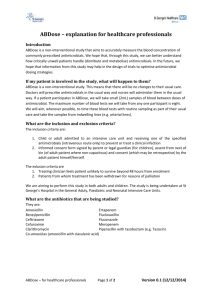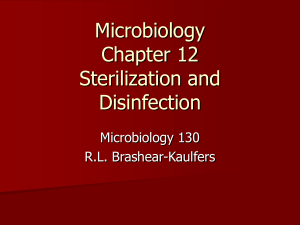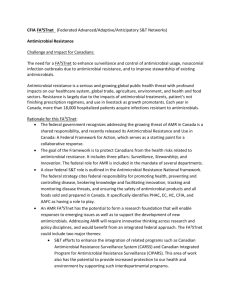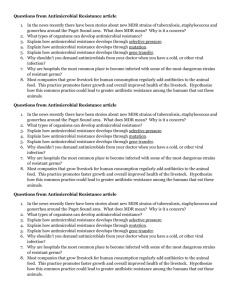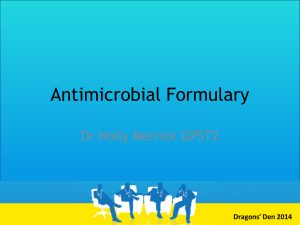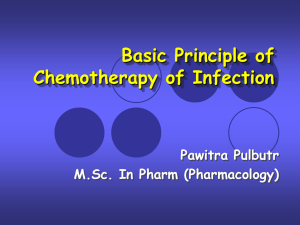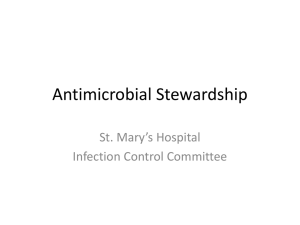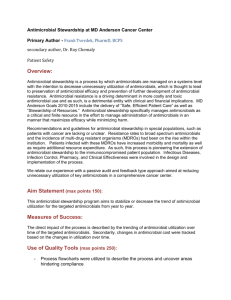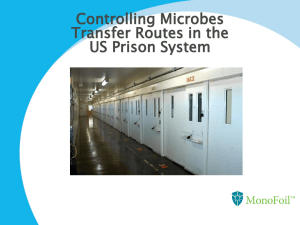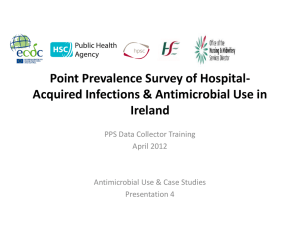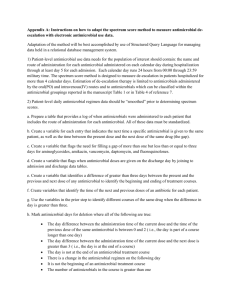antimicrobials and the evolution of eusociality
advertisement
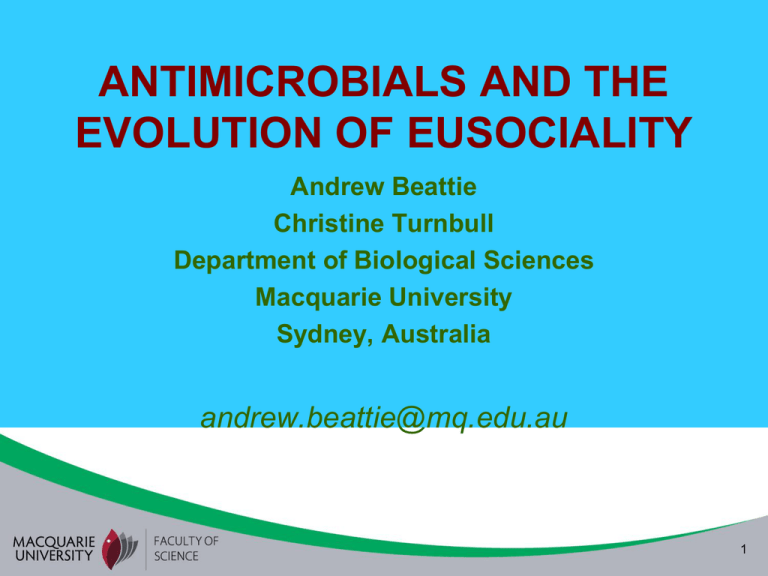
ANTIMICROBIALS AND THE EVOLUTION OF EUSOCIALITY Andrew Beattie Christine Turnbull Department of Biological Sciences Macquarie University Sydney, Australia andrew.beattie@mq.edu.au 1 The major social insects Ants (© Ron Oldfield) Social wasps ©Micropolitan.org Social bees ©2008 Peter O www.aussiebee.com.au Termites www.evergreenpest.com.au 2 Criteria for Eusociality 1. Cooperative brood care 2. Reproductive division of labour; castes 3. Overlap between at least two generations; offspring assist parents 4. Is there another one? 3 THIS TALK • • • • • Bull ants Bees Wasps Thrips (Bioprospecting) 4 5 Bull Ants have two defences against antimicrobial attack 1. EXTERNAL • Paired metapleural glands • Strong antiseptic 6 Extracting antimicrobial metapleural secretions 7 Metapleural secretion activity against microorganisms Yeasts (fungi):strong Gram + bacteria:mixed Gram –ve: strong 8 Bull Ant Antimicrobial defences: 2 – Internal • • • • • • • • Reverse-phase HPLC A: control haemolymph B; challenge haemolymph F1, F2 inducible Oglycosylated proline-rich antibacterial peptides ‘Formaecins’ Non-glycosylated synthetic isoform had very reduced activity J. Biol. Chem. 273:61396143 (1998) Jim Mackintosh F1,F2 active against inoculum 9 Summary: Bull Ant Antimicrobials:: external and internal • Two-tier antimicrobial defence system: 1. External antiseptics from metapleural gland 2. Internal immune system with inducible peptides • But all ant species highly eusocial – what about species at earlier stages of sociality? 10 Hypothesis: Antimicrobials increase in strength with group size and level of social organisation • EXPERIMENT: • To compare social insects that are solitary, semi-social and eusocial • Australian bees: Amegilla, Exoneura, Exoneurella, Trigona • Hypothesis 11 Within-colony density Disease Threat Within-colony genetic diversity solitary Semi-social social 12 Sampling E. robusta– mountain ash forests 13 Sampling E. nigrescensfire induced heathland 14 E. nigrescens Antimicrobial Activity 120 100 80 New Bioassay: 60 40 20 0 1. 80 2. 40 3. 21 4. 27 5. 70 7. 60 10 .1 3 13 .5 1 18 .0 1 24 .0 1 32 .0 1 42 .6 9 Percent Growth E. nigrescens 2 Surface area (mm ) Opposing gradients of antimicrobial strength and microbial inoculum Growth of golden staph completely inhibited 15 Antimicrobial Strength: Minimum Inhibitory Concentrations Status Species Solitary A.cingulata Solitary A. bombif. MIC (50) 201 220 MIC(100) 362 280 SemiSemi- E. robusta E. nigresc. 29 15 38 17 Social Social Ex. Trident. T. carbon. 50 0.7 68 2.2 16 • ANTIMICROBIAL STRENGTH IN BEES POINT OF NO RETURN? density • • • genetic diversity solitary semi-social eusocial 17 • Conclusions: • Group size and within-colony relatedness inceases with increasing sociality. • (Fungal loads were greatest in solitary species) • Antimicrobials strong in social bees, weakest in solitaries • Major increase in antimicrobial strength with first signs of sociality 18 Antimicrobial Activity of Wasps species. 19 Wasp Summary: • Social species showed significantly higher (18x) antimicrobial activity than solitary species • The most important variable leading to increased antimicrobial strength was increase in group size and social complexity. 20 Antimicrobials in Thrips: solitary and social 21 LB Control Lb + extract Social Thrips Social Wasps solitary Staph Control Solitary thrip extract no effect at 180 thrip equivalents Wasp extract effective at 1/32nd of a wasp equivalent Social thrip extract effective at 50 thrip equivalents 22 Concentration–growth response curves showing activity of extracts from eight thrips species against S. aureus. Soc eusoc Semi -soc Turnbull C et al. Biol. Lett. doi:10.1098/rsbl.2010.0719 23 ©2010 by The Royal Society Next phase the only known eusocial beetle: Astroplatypus incompertus 24 Antimicrobial traits and the evolution of sociality/eusociality (i) Social evolution means increasing group size and colony complexity; manifestly increasing the need for antimicrobial defences. Thus, the traits that enabled nascent colonies to combat microbial pathogens have been fundamental to social evolution in thrips and should be included with the other essentials. 25 Antimicrobial traits and the evolution of sociality (ii) Was there a role for microbial pathogens in social evolution? 1) The first response appears to have been an increase in the strength of antimicrobial compounds. 2) Limits to this response, e.g. resource limitation or selfantibiosis might require an increase the number of individuals producing antimicrobials. This scenario embeds a role for microbial pathogens in the social evolution of thrips. What about all the other social insect groups? 26 Bioprospecting using ecological and evolutionary hypotheses • Already big-time (NIH) (www.fic.nih.gov/programs) • Evolutionary and Ecological Applications • J. Biological Engineering • J. Biomimicry • Hypothesis-Driven Bioprospecting 27 For pharmaceuticals in general (Henkel et al. 1999,Angew. Chem. Int. Ed. 38:643) BNPD total (29.432) bacteria (10.417) sugars macrocycles plants (7.323) quinones fungi (8.161) peptides N-heterocycles marine macroorganisms (2.959) O-heterocycles algae (1.276) alicycles arenes rare actinomycetes (1.915) aliphatics others insects/worms (244) molluscs (442) 0% 20% 40% 60% 80% 100% 28 Sources of Drugs 1981-2002 (from Newman et al. 2003. Journal of Natural Products) All NEW COMPOUNDS • 28% from natural product or derivative • 24% based on natural product or mimic 52% ALL ANTICANCER DRUGS • 40% from natural product or derivative • 21% based on natural product or mimic 61% 29 30 THANKS TO • • • • • • • • • • ADAM STOW CHRISTINE TURNBULL DAVID BRISCOE MICHAEL GILLINGS JIM MACINTOSH SHANNON SMITH HELEN DOCHERTY RUTH BURTON DUNCAN VEAL PAUL DUCKETT • • • • • • • • • • • KEIRA BEATTIE DOUG BEATTIE SAM HUSSEY SIOBHAN DENNISION PETER WILSON DAVID NIPPERESS MICHAEL SCHWARTZ STEPHEN HOGGARD CHRIS PALMER TOM CHAPMAN HOLLY CARAVAN 31

